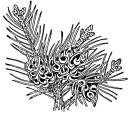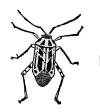|
|
Back to Cues Walkabout
|
CUES Walkabouta collaborative project with The Bell Museum of Natural History and The Minnesota Landscape Arboretum) |
|
Integrated Pest Management Tour at the Minnesota Landscape Arboretum |
IPM is a decision-making process for determining if treatments are necessary, when the best time is for their application, where the treatments are needed, and what treatment methods will be used. The components of an IPM program are:
|
 |
IPM encourages the conservation of naturally occurring biological control organisms (predators, parasites, and pathogens) to control pests. An example of biological control is ladybird beetles killing and eating the aphids feeding on plants.
The wise use of chemical controls is one of the most important ways of conserving natural enemies. Chemical controls are used only when needed, and are applied at the point in the pest's life cycle when it is most vulnerable. Soft pesticides, such as horticultural oils, insecticidal soaps, and microbial insecticides are recommended since they have lower toxicity and fewer effects on organisms other than the pest (non-target effects). The use of these biologically rational pesticides - instead of hard pesticides, in conjunction with the practices of targeting pesticide applications to only the areas where pests are active, and applying pesticides only at the time which pests are most vulnerable, allows more of the natural biological control agents to survive.
[TOP]
The first step in IPM is being able to recognize some of the organisms that damage plants. This is intended as a brief, self-guided walking tour to familiarize yourself with some of the insects and diseases found on plants in Minnesota.
 Cooley
spruce gall (Adelges cooleyi) on Black Hills spruce (Picea glauca
var. densata). This adelgid (an aphid-like insect) causes galls
to form on the branch tips of various spruce species. Initially, the branch
tips appear swollen, with the final stage having the appearance of a dry,
brown pine-cone with needles. Control is normally not needed for this pest,
but if they are unsightly, the galls can be pruned off by hand. After a gall
is formed, the adults emerge and fly to Douglas fir (Pseudotsuga menziesii)
to continue their life cycle. Pesticides such as carbaryl are used to control
these adelgids in the summer when infesting Douglas fir.
Cooley
spruce gall (Adelges cooleyi) on Black Hills spruce (Picea glauca
var. densata). This adelgid (an aphid-like insect) causes galls
to form on the branch tips of various spruce species. Initially, the branch
tips appear swollen, with the final stage having the appearance of a dry,
brown pine-cone with needles. Control is normally not needed for this pest,
but if they are unsightly, the galls can be pruned off by hand. After a gall
is formed, the adults emerge and fly to Douglas fir (Pseudotsuga menziesii)
to continue their life cycle. Pesticides such as carbaryl are used to control
these adelgids in the summer when infesting Douglas fir.
 Birch
leaf miner (Fenusa pusilla) on river birch (Betula nigra).
Leaf miners are larvae of sawflies (a non-stinging wasp) that develop between
the upper and lower layers of a leaf. They begin feeding in the spring and
cause irregularly-shaped, dry, tan patches on the leaves. Proper timing is
essential for effective treatment. Controls should be implemented at the time
of egg laying, which is in spring after the leaves have expanded fully. Use
a systemic pesticide, such as acephate.
Birch
leaf miner (Fenusa pusilla) on river birch (Betula nigra).
Leaf miners are larvae of sawflies (a non-stinging wasp) that develop between
the upper and lower layers of a leaf. They begin feeding in the spring and
cause irregularly-shaped, dry, tan patches on the leaves. Proper timing is
essential for effective treatment. Controls should be implemented at the time
of egg laying, which is in spring after the leaves have expanded fully. Use
a systemic pesticide, such as acephate.
 Four-lined
plant bug (Poecilocapsus lineatus) on mums (Dendranthemum sp.)
and ligularia (Ligularia sp.). These easily recognizable insects
feed on more than 250 species of trees, shrubs, and herbs. They suck plant
juices and leave small darkened circles where they inserted their mouthparts.
They are best controlled with horticultural oil sprayed in May when the insects
are immature.
Four-lined
plant bug (Poecilocapsus lineatus) on mums (Dendranthemum sp.)
and ligularia (Ligularia sp.). These easily recognizable insects
feed on more than 250 species of trees, shrubs, and herbs. They suck plant
juices and leave small darkened circles where they inserted their mouthparts.
They are best controlled with horticultural oil sprayed in May when the insects
are immature.
 Deer
browse damage on arborvitae (Thuja occidentalis). This damage is
caused by feeding deer, and can be differentiated from other types of damage
by the ragged ends of the chewed branches. Deer repellents have some effect,
though fencing is a preferable approach.
Deer
browse damage on arborvitae (Thuja occidentalis). This damage is
caused by feeding deer, and can be differentiated from other types of damage
by the ragged ends of the chewed branches. Deer repellents have some effect,
though fencing is a preferable approach.
 Powdery
mildew (many species) on Beebalm (Monarda fistulosa). Powdery mildew
is a fungus that occurs on many plant species. The grey-white fungus is found
on leaves and sometimes stems, and can cause leaf distortion. Control by pruning
to increase sun penetration and air movement. Rake out and destroy infected
leaves in the fall. If heavily infested, spray with oil or an anti-transpirant.
Powdery
mildew (many species) on Beebalm (Monarda fistulosa). Powdery mildew
is a fungus that occurs on many plant species. The grey-white fungus is found
on leaves and sometimes stems, and can cause leaf distortion. Control by pruning
to increase sun penetration and air movement. Rake out and destroy infected
leaves in the fall. If heavily infested, spray with oil or an anti-transpirant.
If you wish to learn more about the pests that attack landscape plants and how to control them, see the CUES display in the Andersen Library at the Minnesota Landscape Arboretum.
Return to Top
Back to Cues Walkabout
 |
(C) Regents of the University of
Minnesota. All rights reserved. |
 |
 |